Research Achievement
2021
엑시톤 준입자들은 레이저 등의 주사에 의해 여기되어 발견되는 반도체 물질의 기본적은 여기 준입자로서 다양한 광소자와 새로운 양자정보소자의 기본 요소로서 널리 연구되어 오고 있다. 하지만 그 수명이 매우 짧고 저온에서만 관측되어 소자활용에 제약이 있었다. 다른 한편 반금속물질 등에서는 특수한 조건하에 자발적으로 많은 엑시톤들의 형성될 수 있음이 오래전부터 이론적으로 예측되어 왔으나, 이러한 상태(엑시톤절연체)를 지니는 물질이 분명하게 발견되지 않았다. 본 연구에서는 최근 자발적 엑시톤 상태가 발현될 것으로 예측된 Ta2NiSe5 결정에 대한 편광의존 각분해광전자분광실험을 실시하여 실온보다 높은 온도에서 자발적으로 형성된 엑시톤으로부터의 광전자방출을 직접 측정하는데 성공하였다. 이를 통해 이 물질의 엑시톤절연체임이 확실해졌으며, 자발적으로 형성된 엑시톤의 크기 등의 정보를 추출할 수 있었다. 본 연구는 오랫동안 증명되지 않았던 엑시톤절연체 가설을 증명함과 동시에 엑시톤을 활용한 실온에서의 다양한 첨단소자의 가능성을 크게 높였다고 할 수 있다.
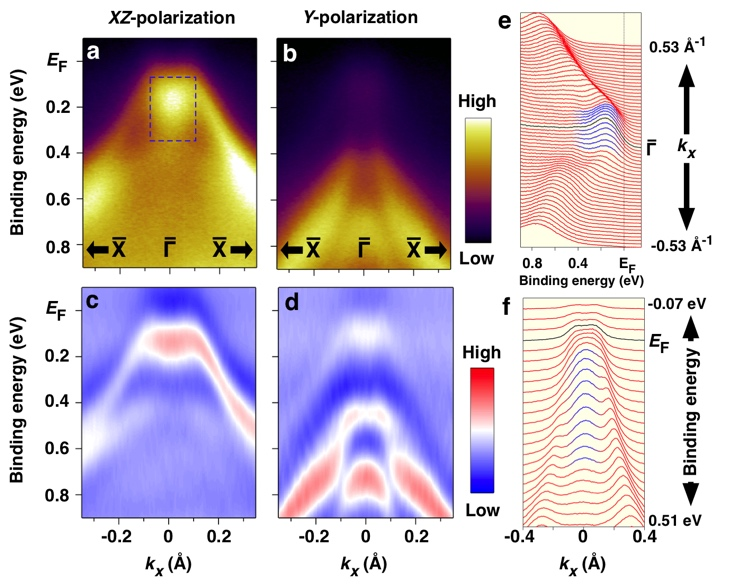
Figure 1 Polarization-dependent angle-resolved photoelectron spectroscopy spectra for Ta2NiSe5, which show the strong non-band origin spectral feature at Brillouin zone center due to spontaneously formed excitons.
Excitons, quasiparticles of electrons and holes bound by Coulombic attraction, are created transiently by light and play an important role in optoelectronics, photovoltaics and photosynthesis. While they are also predicted to form spontaneously in a small gap semiconductor or a semimetal, leading to a Bose-Einstein condensate at low temperature, their material realization has been elusive without any direct evidence. Here we utilize temperature- and polarization (symmetry)-dependent angle-resolved photoemission spectroscopy (ARPES) to investigate the formation and the symmetry of the quasiparticles in a major EI candidate Ta2NiSe5 (TNS) across its anomalous phase transition. Our experimental results below the transition temperature (Tc = 327 K) confirm the hybridization between the valence and the conduction band orbitals near the Fermi level. The origin of this interband hybridization has been debated with excitonic or structural origins. In contrast, the band structure above Tc shows no clear sign of such band hybridization, ruling out a substantial structural effect, but the band gap persists. Moreover, we identify the emergence of a characteristic photoelectron signal, which can only be explained by the direct photoemission from excitons38. This is the first direct signature of the spontaneously formed excitons, the so-called ‘preformed excitons’ preceding the emergence of BEC at a lower temperature39-44. The present results, therefore, guarantee an excitonic insulator transition inTa2NiSe5 at low temperature without any ambiguity related with the structural transition occurring at Tc39,44.
본 연구단의 재료그룹은 반데르발스 물질의 고유한 비등방성으로부터 기인한 다차원적 계면에서 나타나는 새로운 물리적 현상을 재료 플랫폼화 하는 것에 집중하고 있다. 본 연구에서는 두 가지 이상의 서로 다른 원자층 반도체의 반데르발스 에피택시 성장법을 개발했다. 기존, 층과 층 사이에 약한 공유 결합으로 인해 박막이 균일하게 쌓아지지 않아 2차원 반도체 물질의 복합적 접합을 증착하는 기술은 불가능했다. 이번 연구에서는 핵생성과 성장 동역학을 조절한 금속유기화학증착법을 이용하여 서로 다른 원자층 반도체가 9층까지 반복되는 반도체 초격자 구조를 처음으로 구현했다. 개발한 2차원 반도체 초격자 구조 성장법을 이용하면 원자층 수준에서 원자 종류와 주기의 인위적 제어가 가능하다. 이는 새로운 인공 물질을 자유자재로 디자인함으로써, 다양한 전자 구조를 갖는 저차원 전자계 구현으로 이어질 수 있다.
나아가 밸리(valley)라는 전하의 새로운 자유도가 반데르발스 초격자 내 저장됨을 확인했다. 밸리는 2차원 반도체 초격자 구조에서 양자 정보의 매개체로 이용될 수 있는데, 2-유형 밴드 정렬을 갖는 초격자의 반복 횟수와 저장되는 밸리 편광된 전하의 정보가 비례하고, 이 정보가 남아 있음을 초고속분광법으로 확인했다. 이로써 새로운 반도체 초격자가 양자 정보 연산이 가능한 양자 반도체 플랫폼에 활용될 수 있을 것으로 기대된다. 본 연구는 반데르발스 반도체 초격자 구조를 최초로 구현하여 현대 전자 소자 또는 광소자 반도체 기술에 새로운 방향성을 제시한 것이다 (Nature Nanotechnology 2021).

Figure. ML-by-ML vdW heteroepitaxy of MoS2/WS2 superlattices (Nature Nanotechnology 2021).
The CALDES material group focuses on developing the material platforms for new physical phenomena from low-dimensional heterointerfaces, resulting from the intrinsic anisotropy of van der Waals (vdW) materials. In this study, we reported the atomic layer-by-layer epitaxial growth of vdW superlattices with programmable stacking periodicities more than two kinds of dissimilar vdW semiconductors, transition-metal dichalcogenides (TMDCs). Using kinetics-controlled vdW epitaxy in the near-equilibrium limit by metal–organic chemical vapour depositions, we firstly demonstrated precise ML-by-ML stacking, free of interlayer atomic mixing, which resulted in tunable two-dimensional vdW electronic systems.
Furthermore, we confirmed that valley degree of freedom, one of the most distinctive electronic features in vdW ML semiconductors, can be stored in coherent two-dimensional vdW heterointerfaces. By exploiting the series of type-II band alignments, we demonstrated valley-polarized carrier excitations which scale with the stack numbers n in our (MoS2/WS2)n SLs on optical excitations. Designer vdW SLs by epitaxy could serve as scalable platforms for a new type of QW states with distinct vdW interfaces. This study presents that vdW semiconductor superlattice structure paves the way for a new direction in modern electronics, photonics and display technology. (Nature Nanotechnology 2021).
극저온에서 전자의 농도나 외부 압력이 바뀌면서, 원래 나타나던 전자의 정렬 상태가 사라지거나 다른 상태로 변하는 현상이 나타나는데 이를 양자 상전이 현상이라고 한다. 지금까지는 양자 상전이 현상이 일어날 때 보통의 초전도체와 다른, 비고전적인 초전도 현상이 자주 발견됐다. 이때 비고전적인 초전도 현상을 유도하는 중요한 요인 중 하나는 전하정렬 상태가 사라지면서 나타나는 양자요동이라고 여겨졌다. 하지만 아직도 전하정렬 상태와 초전도 상태가 어떤 관계를 가지는지 명확히 밝혀지지 않았다.
본 연구에서는 전하의 공간적인 분포가 선형적인 패턴으로 정렬된 상태를 가지고 있는 이리듐-다이텔루라이드(이하 IrTe2)의 두께를 수십 나노미터 수준으로 박리하여, 2차원 초전도성을 유도하고, 이 초전도 현상이 전하정렬상태와 공존한다는 것을 밝혀냈다. 연구진은 전하의 정렬상태와 초전도 상태 간의 관계를 연구하기 위해 전하 정렬상태를 가지고 있는 물질 중에서도 약한 반데르발스 결합으로 이루어진 층상구조 물질에 주목해왔다. 층 사이가 약한 반데르발스 결합으로 이뤄진 점을 이용하여 물질의 두께를 얇게 함으로써 전하정렬 상태를 조절하였다. 이 경우 구조나 정렬의 결함을 야기하지 않고 물질의 고유 상태를 유지하며 전자 간의 상호작용만 조절할 수 있다는 장점이 있다. 연구진은 저온에서 전하정렬 상태가 나타나는 대표적인 반데르발스 물질인 IrTe2의 두께를 다양하게 조절하면서 전하정렬 상태와 초전도 현상을 체계적으로 조사했다. 이를 통해 수십 나노미터 두께의 IrTe2 박막에서 전하정렬 상태가 여전히 유지되면서 동시에 초전도 현상이 나타난다는 점을 확인했다.
이런 결과는 전하정렬이 약화될 때 나타나는 양자요동으로 초전도 상태가 유도되는 기존의 보고와는 상반되는 결과이다. 특히 이번 연구는 물질의 두께를 조절함으로써 전하정렬의 소멸과 그로 인한 양자요동이 없어도 초전도 현상을 유도할 수 있다는 점을 확인한 첫 사례이다. 향후 두께 조절을 통해 양자 상전이, 그리고 전하정렬 상태와 초전도 상태의 관계를 밝히는 데 중요한 기여를 할 것으로 기대된다.
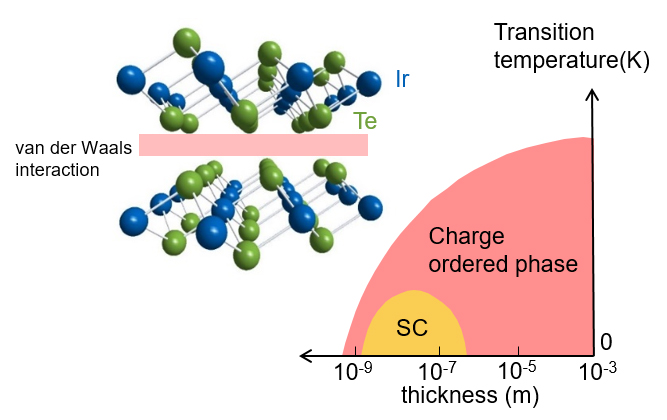
Figure 1. (Left) Crystal structure of IrTe2 with van der Waals gap. (Right) Thickness dependent phase diagram showing a superconducting dome inside the electronic ordered phase.
At ultra-low temperature, upon chemical doping or pressure, the electronic ordered phases are commonly driven into a superconducting phase, resulting in a characteristic dome-shaped phase diagram. This common feature, found in many unconventional superconductors, has supported a prevalent scenario in which fluctuations or partial melting of a parent order are essential for inducing or enhancing superconductivity. Understanding the complex interplay between charge ordering and superconducting instabilities is a long standing issue.
In this study, we found in IrTe2 nanoflakes of which the superconducting dome is identified well inside the parent stripe charge ordering phase in the thickness-dependent phase diagram. Utilising the weak van der Waals (vdW) coupling between layers, we thinned down the IrTe2 single crystals to atomic length scale, comparable with the coherence lengths of their various electronic orders, to tune the stripe order without introducing quenched disorders. The coexisting stripe charge order in IrTe2 nanoflakes significantly increases the out-of-plane coherence length and the coupling strength of superconductivity, in contrast to the doped bulk IrTe2. These findings clarify that the inherent instabilities of the parent stripe phase are sufficient to induce superconductivity in IrTe2 without its complete or partial melting.
This study presents the first example revealing the collaborative role of parent order to the superconductivity without fluctuations or partial melting of the parent order. Our study highlights the thickness control as an effective means to unveil intrinsic phase diagrams of correlated van der Waals materials.
2차원 자석은 차세대 정보소자 후보인 스핀정보소자 구현에 필요한 핵심 소재 중 하나다. 전자 소자가 0과 1 정보를 담은 수많은 트랜지스터로 이루어지듯, 스핀 정보소자에서 스핀 ↑과 ↓정보의 입·출력을 위해서는 다양한 자성상태를 갖는 자석을 서로 접합시켜야 한다. 따라서 2차원 자석에서 자성상태를 조절하는 것은 매우 중요한 과제였다. 그러나 2차원 자석 후보 물질이 드물고, 매우 낮은 온도에서만 자성이 나타나 적합한 소재를 확보하기 어려웠다.
본 연구에서는 4가지 서로 다른 자성 상태를 조절할 수 있는 2차원 자석을 합성해냈다. 당 연구팀은 지난 해 고온에서도 자성이 유지되고 전기가 통하는 2차원 층상 물질인 철-저마늄-다이텔루라이드(이하 Fe4GeTe2)의 설계 및 합성에 성공한 바 있다. 나아가 연구팀은 층 사이 자성결합 세기에 따라 Fe4GeTe2의 자성상태가 민감하게 변하는 데 착안하여, 층간 결합 세기를 조절하기 위해 Fe4GeTe2의 일부 철 원자를 다른 원자로 치환하는 실험을 계획했다. 철 원자와 비슷한 망간, 코발트, 갈륨, 루테늄 원자를 후보로 하여, 각 원자로 치환했을 때 자성상태를 계산하고 실제 합성과 측정 실험을 수행했다. 그 결과 철을 코발트로 치환한 철-코발트-저마늄-다이텔루라이드(이하 Fe4-xCoxGeTe2)가 4가지 자성상태를 가질 수 있음을 발견했다. Fe4-xCoxGeTe2는 코발트 원자 농도에 따라 다른 자성상태를 갖는다. 이때 자성의 정렬에 따라 강자성과 반강자성, 방향에 따라 수직 이방성과 수평 이방성이 조합되는 4가지 자성상태를 가질 수 있었다.
이번에 발견한 물질은 코발트 농도 뿐 아니라 박막의 층수를 조절해 자성 상태를 조절할 수 있다. 4가지 자성상태는 특정 온도 영역에서 나타나는데, 층수에 따라 그 영역이 달라진다. 따라서 층수를 변경하면 같은 온도라도 다른 자성 상태를 갖게 된다. 이는 자성상태를 조성과 두께를 이용해 자유자재로 조절할 수 있는 최초의 2차원 자석을 합성한 성과로, 향후 서로 다른 자성상태의 층을 결합하면 스핀정보 처리에 유용한 특성을 유도할 수 있을 것으로 기대된다.
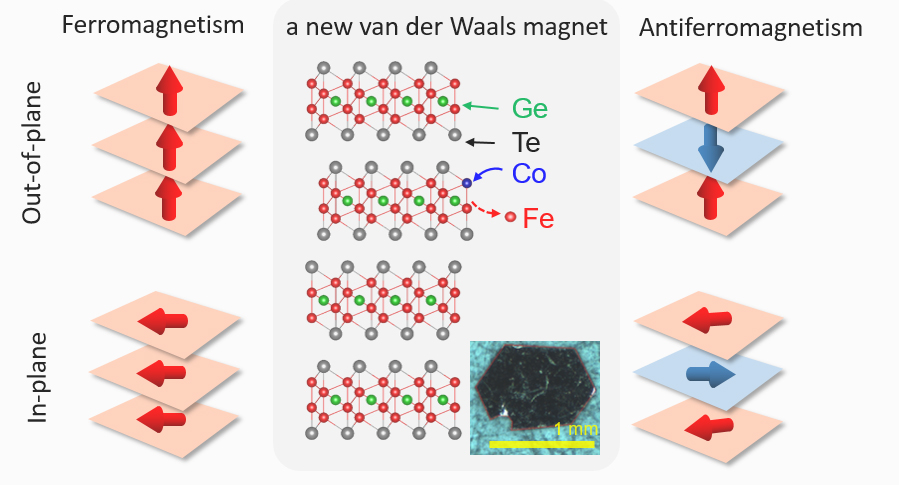
Figure 1. (Center) Crystal structure of a newly-synthesized van der Waals magnet (Fe,Co)4GeTe2 and the optical image of the single crystal. (Left and Right) Four different magnetic states with the ferromagnetic/antiferromagnetic spin configurations and the out-of-plane/in-plane spin orientations.
Discovery of two dimensional (2D) magnets, showing intrinsic ferromagnetic (FM) or antiferromagnetic (AFM) orders, has accelerated development of novel 2D spintronics, in which all the key components are made of van der Waals (vdW) materials and their heterostructures. High-performing and energy-efficient spin functionalities have been proposed, often relying on current-driven manipulation and detection of the spin states. In this regard, metallic vdW magnets are expected to have several advantages over the widely-studied insulating counterparts, but have not been much explored due to the lack of suitable materials.
Here, we report tunable itinerant ferro- and antiferromagnetism in Co-doped Fe4GeTe2 utilizing the vdW interlayer coupling, extremely sensitive to the material composition. This leads to high TN antiferromagnetism of TN ~ 226 K in a bulk and ~ 210 K in 8 nm-thick nanoflakes, together with tunable magnetic anisotropy. The resulting spin configurations and orientations are sensitively controlled by doping, magnetic field, and thickness, which are effectively read out by electrical conduction. These findings manifest strong merits of metallic vdW magnets as an active component of vdW spintronic applications.
일반적인 금속은 전자의 들뜸이 준입자로써 설명되는 란다우 페르미 액체 이론으로써 기술된다. 하지만 구리산화물과 같은 고온 초전도체 물질에서 초전도상태에 인접한 "Strange Metal"이라는 금속성 상태는 페르미 액체 이론을 따르지 않는다는 것이 실험적으로 잘 알려져 있다. 이에 따라 란다우 페르미 액체 이론을 따르지 않는, 흔히 말하는 비 페르미 액체가 주목을 받아왔다.
본 연구단은 뒤틀린 이중층 그래핀, 그래핀 위의 헬륨, 무아레 전이금속 등에서 볼 수 있는, 1차원 도선이 규칙적으로 연결된 2차원 네트워크 초격자 구조[Figure (a)]를 연구하였다. 특히, 2차원 네트워크 초격자 구조에서는 초전도 현상, 스핀 액체를 비롯한 다양한 양자 다체 현상을 이러한 시스템에서 관측할 수 있음과, 무엇보다 TiSe2에서는 압력과 문턱 전압에 따른 저항의 온도 의존성이 페르미 액체 이론의 결과와 다름이 알려져 있다. 한편, 충분히 높은 온도에서는 양자 결맞음 길이가 짧아짐에 따라 네트워크 초격자상의 전자가 국소적인 1차원 도선만 느낄 수 있게 된다 [Figure (c)]. 본 연구팀은 이 사실에 착안하여 2차원 네트워크 초격자를 1차원 도선의 배열로서 모델링하였고, 각 도선이 만나는 연결 지점에서의 전자들의 상호작용에 대한 섭동이론으로 전기적 전도율을 계산하였다 [ Figure (a)]. 각 연결점에서 전기적 전도율은 전체 네트워크 초격자의 전기적 전도도로 확장이 가능하다. 그 결과 네트워크 초격자의 전기적 전도도가 란다우 액체 이론과 완전히 다른 온도 의존성을 가짐을 보였을 뿐 아니라, 물질의 세부 사항에 상관없이 전자들의 상호작용의 세기에 의해서만 결정되는 보편적 매개변수로 스케일링 된다는 것을 보였다. 이번 연구는 비-페르미 액체를 구현하는 새로운 모델을 제시하고 있다. 특히, 이론 모델은 현실의 다양한 물질 군에서 구현될 것으로 믿어지며, 이는 기존의 이론으로 잘 설명되지 못한 많은 강상관 비-페르미 전자계 관련 실험들을 설명해줄 것으로 기대되고 있다.
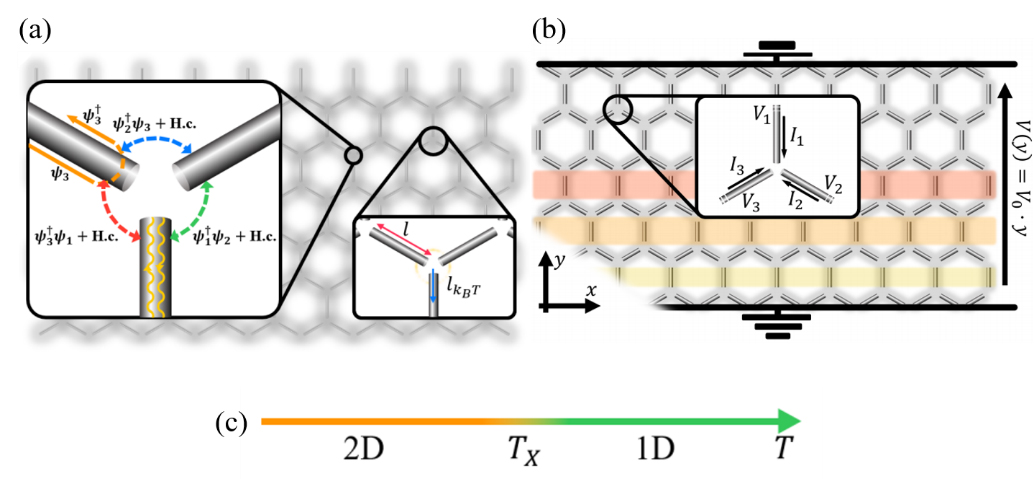
Figure. (a) Schematic picture of honeycomb network. Links are one dimensional Tomonaga-Luttinger liquids and the arrows show the interaction between them. (b) Conduction through the network. Wires with the regions of the same colors have same voltage. (c) "Phase diagram" of the network in temperature.
The electronic excitation in almost of metals has been successfully described by electronic quasiparticles and the corresponding Landau-Fermi liquid theory. However, at the same time, it is also well established that some of the metallic states do not follow the standard Landau-Fermi liquid theory. Those states are often called as non-Fermi liquids. The non-Fermi liquid is believed to be a key of the physics of the high-Tc superconductor.
In our study, the physics of the novel non-Fermi liquids emerging from conducting networks was explored, where 1D metallic wires are joined to form a periodic 2D superstructure. Such superstructure naturally appears in several different materials, e.g. marginally twisted bilayer graphenes, moiré transition metal dichalcogenides, and also some charge-density wave materials. In these materials, we have discovered that at the high-enough temperature, the electron only "feels" a local one-dimensional wire (without realizing that it is a part of the regular 2D superstructure) because of the short coherence length. From this observation, we modelled the network superstructure as an array of the Tomonaga-Luttinger liquid theory, the most famous and well-established non-Fermi liquid, and used the perturbation theory between the wires to compute the conductivity of the whole 2D network, which shows markedly different scaling behaviors than a regular 2D Fermi liquid. This work may explain the physics behind the non-Fermi transports observed in some of network materials and also predict the emergence of the new non-Fermi liquids in twisted bilayer graphene and moiré materials.
고체 내 다체 상호작용은 기존의 밴드 이론으로 설명하기 힘든 고온 초전도 등의 독특한 현상을 만들어내며, 이들의 메커니즘을 이해하는 것은 응집물질물리 분야의 숙제로 자리매김하고 있다. 이런 현상 중 하나로써 엑시톤 절연체는 전자-양공 쌍의 강한 상호작용에 기인하고, 초유동성 등의 물성 덕에 물리적으로나 공학적으로나 중요한 가치를 지니고 있다. 이론 상으론 이미 반 세기 전에 예측되었음에도 불구하고, 실제 3차원 물질에서의 실험적 증거는 현재까지도 불분명한 상태이다. 후보 물질인 Ta2NiSe5의 경우 전기적 상전이와 구조적 상전이가 동시에 일어나기에, 엑시톤 절연체가 아닌 일반적인 밴드 절연체라는 주장이 지속적으로 제기되고 있으며, 이 문제에 대한 확실한 실험적 증거는 미비한 상황이다.
김범준 부단장이 이끄는 분광학 연구팀은 편광 분해 라만 분광법을 활용하여 Ta2NiSe5의 상전이가 구조적 요인이 아닌 전자적 요인에서 비롯됨을 밝히고, 해당 물질에서 엑시톤 절연체의 가능성을 확인하는 결정적인 단서를 관측하였다. 기존 연구에서는 발견하지 못했던 저에너지의 새로운 전자 라만 산란 신호를 관측하였다. 또한 추가적인 분석을 통해 해당 신호가 전자-양공 쌍과 같은 대칭성을 지닌다는 사실과, 전기적 라만 감수율이 상전이 온도 위에서 온도의 역수에 비례하는 퀴리-바이스 현상을 보이는 것을 확인하였다. 이를 통해 Ta2NiSe5의 상전이가 전자적 불안정성에 기인함을 직접적으로 밝혀내었으며, 구조적 요인과 밀접한 관련이 있는 포논이 상전이 온도 근처에서 사라지지 않는다는 점을 토대로, 상전이 현상의 원동력에서 구조적 요인을 배제하였다.
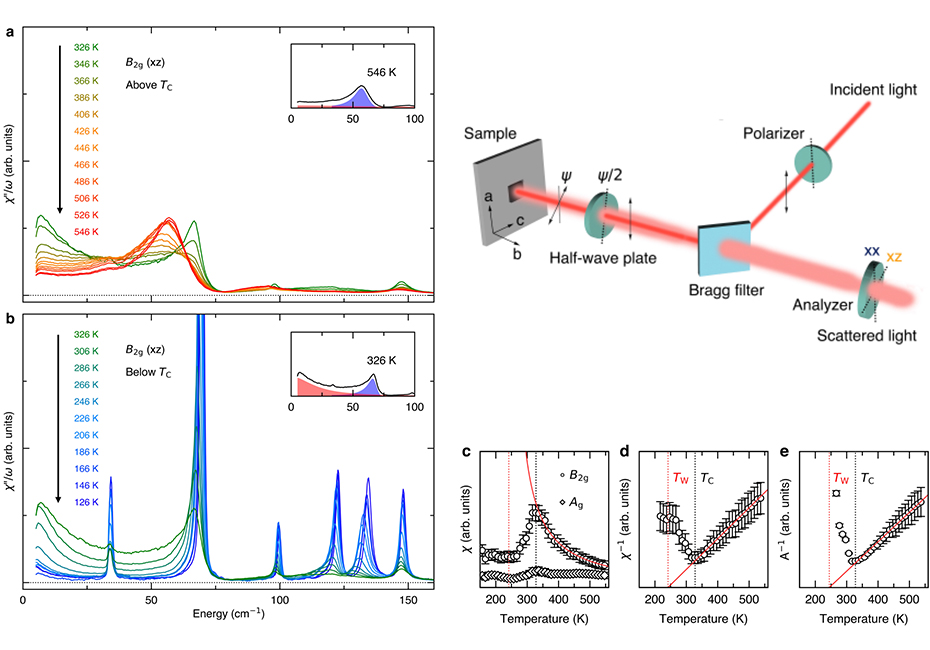
Figure 1. Static electronic susceptibility of Ta2NiSe5 extracted Raman spectra. a,b, Quasielastic scattering intensity increases near the transition temperature (TC=325 K) and c,d,e, static electronic susceptibility follows Curie-Weiss behavior.
Many-body interactions create novel phenomena such as high-temperature superconductivity that cannot be explained by single-electron band theory, and understanding their mechanisms is a central theme in condensed matter physics. An exotic example is the so-called exciton insulator, which is believed to arise from strong interaction of electron-hole pairs, and have important physical and engineering value due to their physical properties such as superfluidity. Although theoretically predicted more than half a century ago, experimental evidence for actual 3D materials remains unclear till today. In the case of the candidate material Ta2NiSe5, its simultaneous electronic and structural phase transitions have long been an issue of controversy; whether the insulating phase is a band insulator or an exciton insulator, and definitive experimental evidence for this problem has been lacking.
The spectroscopy group led by associate Director Bumjoon Kim used polarization-resolved Raman spectroscopy to reveal that the phase transition of Ta2NiSe5 originates from an electronic origin, and observed a decisive clue to confirm the possibility of an exciton insulator in the material. A low-energy, quasi-elastic Raman scattering signal was observed, which was not found in previous studies. In addition, through additional analysis, it was confirmed that the signal has the same symmetry as the electron-hole pair, and that the electrical Raman susceptibility exhibits a Curie-Weiss phenomenon that is proportional to the inverse of the temperature above the phase transition temperature. Through this, it was directly revealed that the phase transition of Ta2NiSe5 is due to electronic instability. Further, the study ruled out the possibility of lattice driven phase transition by showing the absence of phonon softening
본 연구단의 재료그룹은 빛을 이용해 원자 수준으로 얇은 이차원 반데르발스 반도체의 점 결함을 제어함으로써 선택적, 가역적 도핑을 유도하는 “광유도 도핑” 기술을 정립하였다. 이차원 반도체의 점 결함을 자유자재로 조절하고 응용하는 분야의 선두주자로서, 본 리뷰 논문에서는 이차원 반데르발스 반도체와 관련한 다양한 도핑 메커니즘을 정립하고, 도핑에 관여된 점 결함의 식별 및 전기적, 광학적 물성 제어를 통한 소자로의 응용에 대한 연구를 집대성한다.
나아가 본 리뷰 논문에서는 딥러닝(Deep learning) 기술을 투과전자현미경(TEM) 분석에 접목하여 도펀트, 혹은 점결함의 원자 수준에서의 규명 및 통계적 분석을 자동화하는 진보된 기술을 제시한다. 제안된 기술을 통해 이차원 반도체의 점 결함을 확인하고 분류하는 검사의 정확도 및 신뢰성을 매우 높일 수 있다. (Nano Letters 2021).
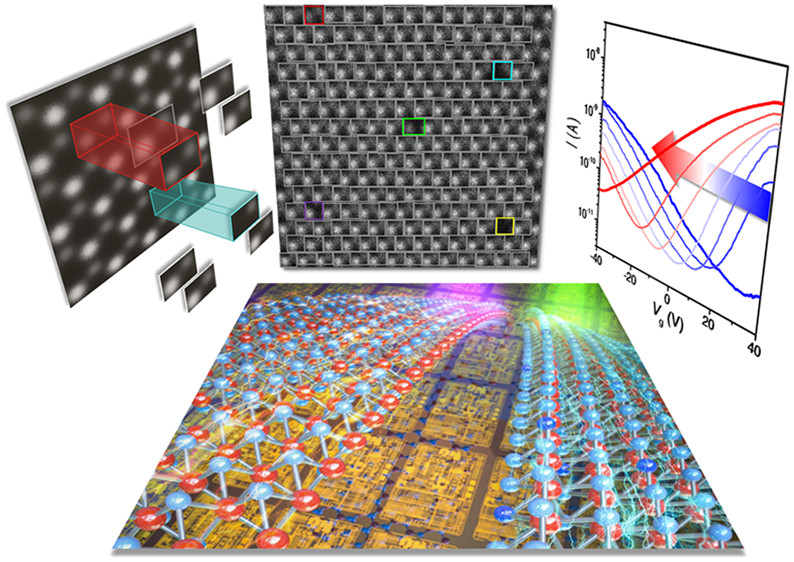
Figure. Identification of point defects in 2D semiconductors as active dopants (Nano Letters 2021)
The CALDES material group has established a “photo-induced doping” technique which induces selective and reversible doping by controlling point defects in atomically thin 2D van der Waals (vdW) semiconductors via shining light. As a pioneer of the field of controlling and applying point defects in 2D vdW semiconductors, in this review paper, we compiled diverse doping mechanisms related to 2D vdW semiconductors, as well as the identification of point defects involved in doping, and their application to electronic and optoelectronic devices.
Furthermore, in this review paper, we propose an advanced technique for automating the atomic-level identification and statistical analysis of point defects by applying deep learning technology to TEM analysis. The accuracy and reliability of inspection for identifying and classifying the point defects of 2D semiconductors can be greatly improved through the proposed deep neural network methods. (Nano Letters 2021)..
위상 절연체와 같이 위상학적 질서를 갖는 물질 연구가 최근 응집 물질 물리학 분야의 커다란 화두이다. 특히 자유 전자가 갖는 밴드 구조 이론과 결정 대칭성에 대한 심도 깊은 수학적 군론의 결합을 통해, 수많은 새로운 위상학적 물질이 이론적으로 발견되고 있다. 하지만 새롭게 발견된 수많은 위상 절연체들은 어떠한 종류의 위상학적 특성을 갖고 있는지가 잘 알려지지 않았다. 또한 대부분 자유 전자 이론에 기반하여 발견된 새로운 위상 상태들에, 실제 물질에서 존재하는 강한 전자 간의 상호작용을 더했을 때에도 위상학적 특성이 잘 정의될 수 있을지는 미지수이다.
본 연구에서는 다양한 위상 절연체들에 대해 보편적으로 사용 가능한 새로운 위상학적 불변량을 제안하고 있다. 구체적으로, 천 절연체(chern insulator)와 카이랄 힌지 절연체(chiral hinge insulator)에 대한 새로운 불변량을 발견했다. 발견된 불변량들은 다체 기저 상태(many-body ground state)만을 사용하여 계산이 되기 때문에 구체적 헤밀토니언의 모양과 무관하게 항상 적용이 가능하다. 따라서 발견된 불변량들은 전자 간의 상호작용이 강한 상황과 불순물 및 결함이 있는 상황에서도 사용이 가능하다.
본 연구단은 새로 찾아낸 불변량들이 올바르게 위상 물질을 분류함을 보이기 위해서 다양한 이론적 방법론을 사용하였다. 본 연구단은 먼저 위상학적 장론을 사용해 불변량이 위상학적 수송 현상의 유무를 판별 해냄을 보였고, 더불어 발견된 불변량이 기존에 알려진 밴드 구조 이론에서의 불변량과 연관되어 있음을 보였다. 또한 연구진은 정확한 대각화(exact diagonalization) 및 텐서 그물망(tensor network)을 통한 수치 해석 시뮬레이션을 사용하여, 불변량들이 상호작용이 강할 때에도 이론적으로 기대되는 위상학적 불변량과 일치한다는 사실을 확인했다.
이번 성과는 2차원 자성체를 설계한 최초의 사례인데다, 전기전도성까지 부여하는 데 성공해 향후 차세대 스핀 소자 스핀정보소자에 활용이 기대된다. 또한 다른 2차원 물질과 쉽게 결합할 수 있다는 장점도 있어 향후 서로 다른 2차원 물질을 접합해 만들어질 스핀정보소자 연구에 활용이 기대된다.
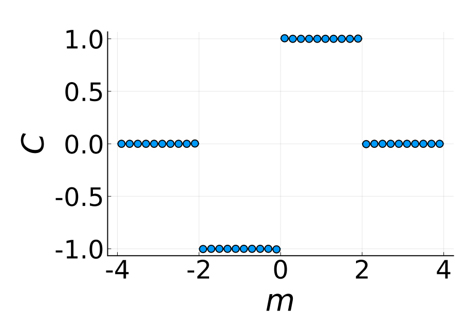
Figure 1. The phase diagram of non-interacting Chern insulator computed from our many-body invariant.
Materials having intrinsic topological orders, including topological insulators, have been extensively investigated in the field of condensed matter physics. In particular, new topological materials have been theoretically predicted from the free-electron band theory with the well-developed group theoretical understanding of crystalline symmetries. However, topological properties of those newly-discovered topological states are still unclear. Furthermore, whether the topological nature, if there is, of the states can be well defined in the presence of the strong interactions is entirely unclear.
In this work, we proposed a set of new many-body topological invariants that applies to a broad class of topological insulators. Specifically, we found new invariants for the 2D Chern insulator and 3D chiral hinge insulator. Since the definition of our invariants only involves the many-body ground states, their applicability is not limited by detailed structures of Hamiltonians. Thus, the invariants can be applied to models with strong interactions, disorders, or impurities. In addition, we adopted several new theoretical schemes to confirm the validity of our many-body invariants. First, we provide a topological field theoretical interpretation of the invariants and relate our invariants to the previously-known invariants defined for the free-electron limits. We then showed that the invariants differentiate the existence of corresponding topological pumping processes of a given system. On top of this, we have shown that the invariants correctly give the known phase diagram of interacting Chern and hinge insulators by utilizing the exact diagonalization and tensor network algorithms.
 Center for Artificial Low
Center for Artificial Low